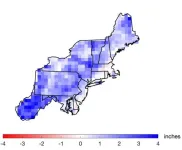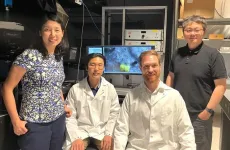(Press-News.org) A New Jersey Institute of Technology research team led by physics professor Wenda Cao at the university’s Center for Solar Terrestrial Research (CSTR) has been awarded a $4.64 million National Science Foundation grant to continue leading explorations of the Sun’s explosive activity at Big Bear Solar Observatory (BBSO).
The grant marks the largest project that the Solar-Terrestrial Research Program under NSF’s Division of Atmospheric and Geospace Sciences (AGS) supports, extending five more years of baseline funding for all science, instrumentation and education activities at BBSO, located at California’s Big Bear Lake.
The funding supports BBSO research through a key phase of increased activity in the 11-year solar cycle, known as the solar maximum. As more sunspots bubble from the Sun’s surface, sudden releases of energy from the star’s magnetic fields — manifesting as solar flares and coronal mass ejections — are expected to intensify as Solar Cycle 25 reaches its maximum by the summer of 2025.
“Big Bear Solar Observatory and its Goode Solar Telescope are a unique asset to the solar physics community, allowing for uninterrupted solar flare studies important for understanding our Sun and space weather effects,” said Lisa Winter, NSF-AGS program director for Solar-Terrestrial Research and SHINE. “Support for this observatory is especially important as our Sun enters solar maximum.”
BBSO, operated by NJIT-CSTR, has long been at the forefront of solar research as home to the 1.6-meter clear aperture, off-axis Goode Solar Telescope (GST). GST is the world’s second highest-resolution solar telescope and pathfinder to NSF’s 4-meter Inouye Solar Telescope (DKIST) stationed in Maui, Hawaii, which became the world’s largest solar telescope after breaking first light in 2020.
“This grant is essential to maintain the telescope in operation, continue advanced research at BBSO/CSTR, support the current talented engineering team, and educate next generation of scientists and engineers.” said Wenda Cao, BBSO director and member of NSF’s Astronomy and Astrophysics Advisory Committee. “GST was the first facility-class solar telescope built in the U.S. in a generation. Under this grant support, GST will continue to be a major player in high-resolution ground-based observations in the U.S. and worldwide. BBSO will continue playing a crucial and irreplaceable role in science, technology, engineering and education.”
The new grant will enable NJIT-CSTR researchers to continue using GST’s unique imaging capabilities and unapparelled “astronomical seeing” conditions at Big Bear Lake to investigate solar phenomenon as activity on the Sun ramps up. It also promises new GST-DKIST collaborations that could yield unprecedented coverage of solar eruptions as they evolve moment-by-moment.
“The project period covering the maximum of Solar Cycle 25 is an important window to study solar activity, especially solar flares and evolution of solar active regions leading to eruptions,” said Cao, whose team collects a flurry of solar data 24/7 at BBSO that includes measurements of the Sun’s magnetic field, flare energetics in lower solar atmosphere and more, which could potentially offer early warning detection for solar storms back on Earth.
“A notable feature of BBSO is the excellent and stable seeing conditions lasting for hours, which is uniquely required to observe such solar eruptions — key sources of space weather that impact the daily life of humans through effects on communication, transportation, power systems, national defense and space travel.”
Since breaking first light 2009, GST’s observations of the Sun’s surface (photosphere) and lower atmosphere (chromosphere) in visible to near-infrared wavelengths have led to transformative insights into the physics driving solar activity and the nature of the solar atmosphere.
The new grant extends NSF’s previous five-year cycle of funding for BBSO, in which NJIT-CSTR researchers enhanced GST observations with spatial resolution better than 0".1 to answer fundamental questions over the fine-scale energy release in active solar events, including how energy from the Sun is transferred to the star's outermost atmosphere.
BBSO’s GST and other world-class instruments have played a vital role to the international space science community, including providing observational support to NASA missions such as the Parker Solar Probe among others. In 2021, BBSO further bolstered its resources by adding NSF’s Synoptic Optical Long-term Investigations of the Sun (SOLIS) — the most advanced solar telescope for long-term monitoring the “Sun as a whole globe” over the complete solar cycle.
Researchers from 63 universities, observatories and institutes across 21 countries now have access to GST observing time and data, the insights from which have yielded more than 100 peer-reviewed papers since 2018 (including one in Science and six in Nature journals), detailing new discoveries about Earth’s nearest star.
To honor BBSO-driven achievements from the international solar research community, NJIT-CSTR has established the “Goode Solar Telescope Prize.” The inaugural prize was presented to noted solar researcher Young-Deuk Park at the sixth biannual GST Workshop, hosted at the Korea Astronomy and Space Science Institute (KASI) in Daejeon from May 23-26.
The new prize has been created “in recognition of the significant contribution of the BBSO partners and outside communities to the facility.” The GST Prize includes a token cash prize of $1000, which is awarded to “a scientist from around the world for outstanding contributions to BBSO operation, GST science and instrumentation development.”
Learn More
END
NJIT researchers awarded $4.6m to unlock mysteries of solar eruptions
National Science Foundation (NSF) awards five-year grant support for Big Bear Solar Observatory research through the maximum of Solar Cycle 25, when the Sun’s explosive activity is expected to peak.
2023-05-30
ELSE PRESS RELEASES FROM THIS DATE:
Extended lymph node removal does not benefit patients with clinically localized muscle-invasive bladder cancer
2023-05-30
An extended lymphadenectomy – removal of additional lymph nodes beyond the extent of the standard procedure – in patients undergoing radical cystectomy (removal of bladder and nearby tissues) because of clinically localized muscle-invasive bladder cancer provides no patient benefit as measured by disease-free survival or overall survival times. It does, however, increase the risk of adverse events (side effects) and post-surgical death.
These primary results from the phase 3 SWOG S1011 clinical ...
Study finds sex education tool improves reproductive health knowledge among adolescent girls
2023-05-30
HUNTINGTON, W.Va. – A Marshall University study found that a virtual sex education tool improved reproductive health knowledge scores and measures of self-efficacy among adolescent girls.
The findings, published last month in Sex Education, a leading international journal on sex, sexuality and relationships in education, found that sexual health knowledge scores on a validated scale increased among participants, along with improved measures of self-efficacy regarding birth control, healthy relationships and sexually transmitted infection (STI) prevention. Notably, ...
No-till revolution could stop Midwest topsoil loss in its tracks
2023-05-30
American Geophysical Union
25 May 2023
AGU Release No. 22
For Immediate Release
This press release and accompanying multimedia are available online at: https://news.agu.org/press-release/no-till-revolution-could-stop-midwest-topsoil-loss-in-its-tracks/
No-till revolution could stop Midwest topsoil loss in its tracks
If Midwestern farms all adopted low-intensity tilling practices or stopped tilling entirely, the erosion of critical topsoil could decrease by 95% in the next 100 years, new study finds
AGU press contact:
Rebecca ...
Computational method uncovers the effects of mutations in the noncoding genome
2023-05-30
Less than two percent of the human genome codes for proteins, with the rest being noncoding and likely helping with gene regulation. Mutations in the noncoding genome often trigger trait changes that cause disease or disability by altering gene expression. However, it can be hard for scientists to track down which of numerous variants associated with a disease or other complex trait are the causal ones and to understand the mechanism of their effects. Researchers at the Brigham developed a new computational approach that hones in on small regions of the noncoding genome that genome-wide association studies (GWAS) identified ...
Extreme precipitation in northeast to increase 52% by the end of the century
2023-05-30
With a warmer climate creating more humid conditions in the Northeast, extreme precipitation events — defined as about 1.5 or more inches of heavy rainfall or melted snowfall in a day — are projected to increase in the Northeast by 52% by the end of the century, according to a new Dartmouth study.
The findings are published in Climatic Change.
"As climate change brings warmer temperatures, you have more water vapor in the atmosphere, which creates the right conditions for extreme precipitation," says first author Christopher J. Picard '23, an earth sciences major and undergraduate researcher in the Applied Hydroclimatology Group ...
Lung infection may be less transmissible than thought
2023-05-30
A little-known bacterium — a distant cousin of the microbes that cause tuberculosis and leprosy — is emerging as a public health threat capable of causing severe lung infections among vulnerable populations, those with compromised immunity or reduced lung function.
Recent research found that various strains of the bacterium, Mycobacterium abscessus, were genetically similar, stoking fears that it was spreading from person to person.
But a new study by Harvard Medical School researchers published ...
Experimental decoy protects against SARS-CoV-2 infection
2023-05-30
An experimental “decoy” provided long-term protection from infection by the pandemic virus in mice, a new study finds.
Led by researchers at NYU Grossman School of Medicine, the work is based on how the virus that causes COVID-19, SARS-CoV-2, uses its spike protein to attach to a protein on the surface of the cells that line human lungs. Once attached to this cell surface protein, called angiotensin converting enzyme 2 (ACE2), the virus spike pulls the cell close, enabling the virus to enter the cell and hijack its machinery to make viral copies.
Earlier in the pandemic, pharmaceutical ...
Light conveyed by the signal transmitting molecule sucrose controls growth of plant roots
2023-05-30
Plant growth is driven by light and supplied with energy through photosynthesis by green leaves. It is the same for roots that grow in the dark – they receive the products of photosynthesis, in particular sucrose, i.e. sugar, via the central transportation pathways of phloem. Dr. Stefan Kircher and Prof. Dr. Peter Schopfer from the University of Freiburg’s Faculty of Biology have now shown in experiments using the model plant Arabidopsis thaliana (thale cress) that the sucrose not only guarantees the supply of carbohydrates to the roots, it also acts as a signal transmitter for ...
Mitigating climate change through restoration of coastal ecosystems
2023-05-30
One of the primary drivers of climate change is excess greenhouse gases like carbon dioxide in the atmosphere. Mitigating climate change in the coming century will require both decarbonization — electrifying the power grid or reducing fossil fuel-guzzling transportation — and removing already existing carbon dioxide from the atmosphere, a process called carbon dioxide removal.
Researchers at the Georgia Institute of Technology and Yale University are proposing a novel pathway through which coastal ecosystem restoration can permanently capture carbon dioxide from the atmosphere. Seagrass and mangroves — known as blue carbon ecosystems — naturally capture ...
Flexible nanoelectrodes can provide fine-grained brain stimulation
2023-05-30
HOUSTON – (May 30, 2023) – Conventional implantable medical devices designed for brain stimulation are often too rigid and bulky for what is one of the body’s softest and most delicate tissues.
To address the problem, Rice University engineers have developed minimally invasive, ultraflexible nanoelectrodes that could serve as an implanted platform for administering long-term, high-resolution stimulation therapy.
According to a study published in Cell Reports, the tiny implantable devices formed stable, long-lasting and seamless tissue-electrode ...
LAST 30 PRESS RELEASES:
Two Keck Medicine of USC Hospitals named Leapfrog Top Teaching Hospitals
World-first discovery uncovers how glioblastoma tumours dodge chemotherapy, potentially opening the door to new treatments
A fatal mix-up: How certain gut bacteria drive multiple sclerosis
New AI tool identifies not just genetic mutations, but the diseases they may cause
Deep-learning model predicts how fruit flies form, cell by cell
Combination pills for high blood pressure may simplify treatment, improve long-term health
Immune system keeps mucosal fungi in check
Neurons within the brain use simple rules to localize genetic messages
Electrodes created using light
Second-hand gift-giving is a well-deliberated decision
How human interaction drove evolution to make bears less aggressive
National Poll: Few parents offer teens guidance on healthy eating during holiday season
Cannabis derivatives could provide new ovarian cancer treatments
Raising strong yeast as a petroleum substitute
Clues to the origin of hot Jupiters hidden in their orbits
Canada’s reduced pledge to Global Fund will impact domestic health
1 in 4 children with major traumatic injuries not cared for in pediatric trauma centres
Duke and Duke-NUS’ joint cross-population research to uncover "East-West" differences in disease and care
Scientists to ‘spy’ on cancer- immune cell interactions using quantum technology breakthrough
Tech savvy users have most digital concerns
Making lighter work of calculating fluid and heat flow
Normalizing blood sugar can halve heart attack risk
Lowering blood sugar cuts heart attack risk in people with prediabetes
Study links genetic variants to risk of blinding eye disease in premature infants
Non-opioid ‘pain sponge’ therapy halts cartilage degeneration and relieves chronic pain
AI can pick up cultural values by mimicking how kids learn
China’s ecological redlines offer fast track to 30 x 30 global conservation goal
Invisible indoor threats: emerging household contaminants and their growing risks to human health
Adding antibody treatment to chemo boosts outcomes for children with rare cancer
Germline pathogenic variants among women without a history of breast cancer
[Press-News.org] NJIT researchers awarded $4.6m to unlock mysteries of solar eruptionsNational Science Foundation (NSF) awards five-year grant support for Big Bear Solar Observatory research through the maximum of Solar Cycle 25, when the Sun’s explosive activity is expected to peak.


